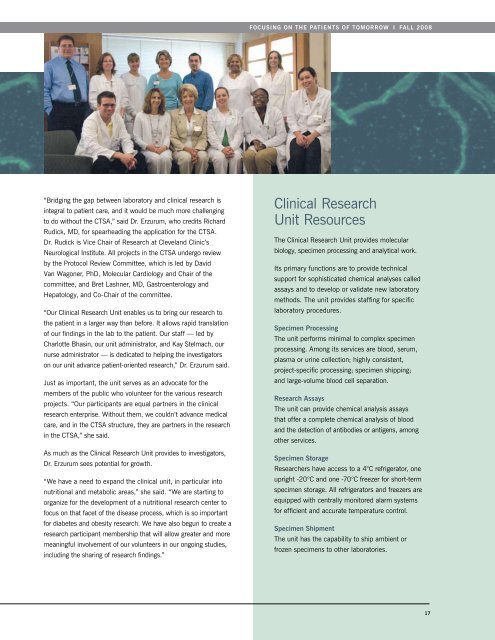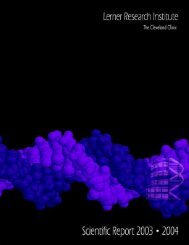Fall 2008 - Cleveland Clinic Lerner Research Institute
Fall 2008 - Cleveland Clinic Lerner Research Institute
Fall 2008 - Cleveland Clinic Lerner Research Institute
You also want an ePaper? Increase the reach of your titles
YUMPU automatically turns print PDFs into web optimized ePapers that Google loves.
Focusing on the patients of tomorrow FALL <strong>2008</strong>“Bridging the gap between laboratory and clinical research isintegral to patient care, and it would be much more challengingto do without the CTSA,” said Dr. Erzurum, who credits RichardRudick, MD, for spearheading the application for the CTSA.Dr. Rudick is Vice Chair of <strong>Research</strong> at <strong>Cleveland</strong> <strong>Clinic</strong>’sNeurological <strong>Institute</strong>. All projects in the CTSA undergo reviewby the Protocol Review Committee, which is led by DavidVan Wagoner, PhD, Molecular Cardiology and Chair of thecommittee, and Bret Lashner, MD, Gastroenterology andHepatology, and Co-Chair of the committee.“Our <strong>Clinic</strong>al <strong>Research</strong> Unit enables us to bring our research tothe patient in a larger way than before. It allows rapid translationof our findings in the lab to the patient. Our staff — led byCharlotte Bhasin, our unit administrator, and Kay Stelmach, ournurse administrator — is dedicated to helping the investigatorson our unit advance patient-oriented research,” Dr. Erzurum said.Just as important, the unit serves as an advocate for themembers of the public who volunteer for the various researchprojects. “Our participants are equal partners in the clinicalresearch enterprise. Without them, we couldn’t advance medicalcare, and in the CTSA structure, they are partners in the researchin the CTSA,” she said.As much as the <strong>Clinic</strong>al <strong>Research</strong> Unit provides to investigators,Dr. Erzurum sees potential for growth.“We have a need to expand the clinical unit, in particular intonutritional and metabolic areas,” she said. “We are starting toorganize for the development of a nutritional research center tofocus on that facet of the disease process, which is so importantfor diabetes and obesity research. We have also begun to create aresearch participant membership that will allow greater and moremeaningful involvement of our volunteers in our ongoing studies,including the sharing of research findings.”<strong>Clinic</strong>al <strong>Research</strong>Unit ResourcesThe <strong>Clinic</strong>al <strong>Research</strong> Unit provides molecularbiology, specimen processing and analytical work.Its primary functions are to provide technicalsupport for sophisticated chemical analyses calledassays and to develop or validate new laboratorymethods. The unit provides staffing for specificlaboratory procedures.Specimen ProcessingThe unit performs minimal to complex specimenprocessing. Among its services are blood, serum,plasma or urine collection; highly consistent,project-specific processing; specimen shipping;and large-volume blood cell separation.<strong>Research</strong> AssaysThe unit can provide chemical analysis assaysthat offer a complete chemical analysis of bloodand the detection of antibodies or antigens, amongother services.Specimen Storage<strong>Research</strong>ers have access to a 4°C refrigerator, oneupright -20°C and one -70°C freezer for short-termspecimen storage. All refrigerators and freezers areequipped with centrally monitored alarm systemsfor efficient and accurate temperature control.Specimen ShipmentThe unit has the capability to ship ambient orfrozen specimens to other laboratories.17
















